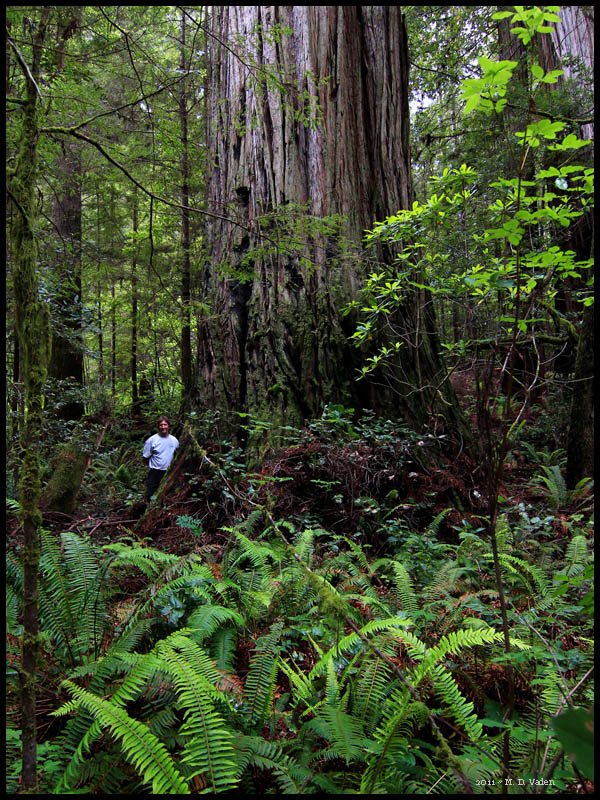
How tall can a Coast Redwood grow?
Can Coast Redwood or Douglas Fir grow to 400' tall?
by Mario Vaden
Ever wondered what the height was, of the tallest Coast Redwood (ever) ? Or other species? There have been reports passed-down for heights exceeding 400 feet. So how tall can Redwoods really grow? While exploring Redwood National Park in 2011, an answer developed for my own mind as facts and thoughts settled.
First, let's keep in mind the research of scientists like Dr. Koch of Northern Arizona University, Dr. Jennings and Prof. Sillett of Humboldt State University and Dr. Davis of Pepperdine University, who studied water inside coast redwoods: the correlation between height, internal water pressure, leaf size, photosynthesis, fog and more. Basically, they concluded that no species can grow higher than 130 meters / 427 feet.

Photo - This is not one of the tallest, but shows the species can exceed expected dimensions in the hills. We found this trunk nearly 20 feet in diameter (2011), 600 feet elevation above Redwood Creek.
Partly because of that research, I easily accept the report of the 393 foot / 120 meter Mineral Tree Douglas Fir. It was measured in 1924 by Dr. Richard E. McArdle, a former chief of the U.S. Forest Service. The volume was 18,190 cubic feet. And that height is only about 13 feet taller than the tallest coast redwood Hyperion, when discovered in 2006. Although Redwood is more decay resistant and can fast, I suspect that Douglas Fir (some) have a better chance to exceed 400 feet: in certain areas.
The one thing that can instill doubt of Coast Redwoods ever being like 450 feet tall, is the remnants that remain.
Only 5% of old-growth Coast Redwood forests remain today. And someone could say that's a small remnant for an opinion. But that remant is actually tens of thousands of acres, which is a gigantic patch of land. And in some forest like Redwood National Park, the areas not logged, were inaccessible well-protected places, ideal for tall redwood growth.
So we now have 1 acre of old-growth left, for every 19 acres that was removed. That still leaves us with about 1 old growth coast redwood for every 19 that were cut down. In that case, we should still have one 400 foot redwood for every 19 four hundred foot ones cut down. But we do not even have one 400 foot redwood on the face of the entire planet.
Sure, some groves of the past may have been in slightly better habitat, but we still have some very good forest land. And there is not only no 400 foot redwood, there is not even a 395, a 390 or a 385.
With Hyperion being almost 380 feet tall (2013), and part of the 5% forest remnant, it seems unlikely that it is the tallest that ever grew. Similar to how the Hemlock (Tsunami) I discovered March 2011, was 23 feet taller than any others known, it seems realistic that 400 Coast Redwoods grew along the west coast in the late 1800s & early 1900s. But not many: those had to be the exceptional specimens.
In a nutshell, I believe the tallest coast redwoods were 370 feet to 400 feet tall, and that wind, their weight and changes in weather restricted them from reaching 420 feet. Even if they could reach the 427 maximum estimated by scientist's research, I don't believe that coast redwoods would make it up that high anyway. If a few squeeked past the 410 foot threshold, they would be more like an anomaly.
The height of the average tall redwood groves of the past, must have bee somewhat comparable to what we see in the remaining 5% of old-growth today.